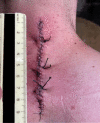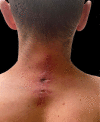Nuchal-type Fibroma Induced by Repetitive Trauma from Weightlifting: Case Report and Comprehensive Review of Literature
- PMID: 38204868
- PMCID: PMC10781125
- DOI: 10.1097/GOX.0000000000005517
Nuchal-type Fibroma Induced by Repetitive Trauma from Weightlifting: Case Report and Comprehensive Review of Literature
Abstract
A nuchal-type fibroma (NTF) is a rare, benign, subcutaneous nodule that most frequently occurs in the posterior neck along the midline. It is characterized histologically by bundles of thick collagen fibers confined to the dermis and subcutaneous tissue of the posterior neck. Few trauma-related NTF cases have been published. We present a biopsy-proven case of NTF that is likely to have developed as a result of weightlifting activity in the gym, including repetitive trauma to the area of the lesion during the exercise known as the "barbell back squat." During this exercise, a heavy barbell was repeatedly rested on the patient's vertebral prominence at the level of C7/T1, the location where the NTF developed. Our 25-year old patient reported that he had been doing this exercise on a weekly basis for about 10 years. We believe that repetitive trauma at this location from specific weightlifting exercises may attribute to the incidence of NTF. A description of key magnetic resonance imaging characteristics and the surgical pathology of this case are provided, along with a review of current literature on trauma-related NTFs.
Copyright © 2024 The Authors. Published by Wolters Kluwer Health, Inc. on behalf of The American Society of Plastic Surgeons.
Conflict of interest statement
The authors have no financial interest to declare in relation to the content of this article.
Figures







Similar articles
-
Atypical Nuchal-Type Fibromas: A Rare Presentation of the Soft Tissue Tumor in the Bilateral Lower Extremities.Cureus. 2025 Apr 25;17(4):e83016. doi: 10.7759/cureus.83016. eCollection 2025 Apr. Cureus. 2025. PMID: 40421352 Free PMC article.
-
Repetitive trauma-induced extra-nuchal-type fibroma.Skeletal Radiol. 2022 Mar;51(3):681-685. doi: 10.1007/s00256-021-03912-7. Epub 2021 Sep 23. Skeletal Radiol. 2022. PMID: 34554278 Free PMC article. Review.
-
Extra nuchal-type fibroma associated with repetitive blunt trauma during religious activities.Trauma Case Rep. 2016 Aug 31;4:16-20. doi: 10.1016/j.tcr.2016.05.007. eCollection 2016 Jun. Trauma Case Rep. 2016. PMID: 29942846 Free PMC article.
-
Nuchal-type Fibroma: Single-Center Experience and Systematic Literature Review.In Vivo. 2020 Sep-Oct;34(5):2217-2223. doi: 10.21873/invivo.12032. In Vivo. 2020. PMID: 32871744 Free PMC article.
-
Nuchal-type fibroma: a clinicopathologic study of 52 cases.Cancer. 1999 Jan 1;85(1):156-63. doi: 10.1002/(sici)1097-0142(19990101)85:1<156::aid-cncr22>3.0.co;2-o. Cancer. 1999. PMID: 9921988
Cited by
-
Atypical Nuchal-Type Fibromas: A Rare Presentation of the Soft Tissue Tumor in the Bilateral Lower Extremities.Cureus. 2025 Apr 25;17(4):e83016. doi: 10.7759/cureus.83016. eCollection 2025 Apr. Cureus. 2025. PMID: 40421352 Free PMC article.
References
-
- Lee GK, Suh KJ, Lee SM, et al. . Nuchal-type fibroma of the buttock: magnetic resonance imaging findings. Jpn J Radiol. 2010;28:538–541. - PubMed
-
- Michal M, Fetsch JF, Hes O, et al. . Nuchal-type fibroma. Cancer. 1999;85:156–163. - PubMed
-
- Enzinger FM, Weiss SW. Benign Tumors and Tumorlike Lesions of the Fibrous Tissue. 2nd ed. St. Louis, MO: C.V. Mosby; 1988:102–135.
-
- Linos K, Šedivcová M, Cerna K, et al. . Extra nuchal-type fibroma associated with elastosis, traumatic neuroma, a rare APC gene missense mutation, and a very rare mutyh gene polymorphism: a case report and review of the literature. J Cutan Pathol. 2011;38:911–918. - PubMed
-
- LeBlanc KG, Wenner M, Davis LS. Multiple nuchal fibromas in a 2‐year‐old without Gardner syndrome. Pediatr Dermatol. 2011;28:695–696. - PubMed
LinkOut - more resources
Full Text Sources
Miscellaneous
